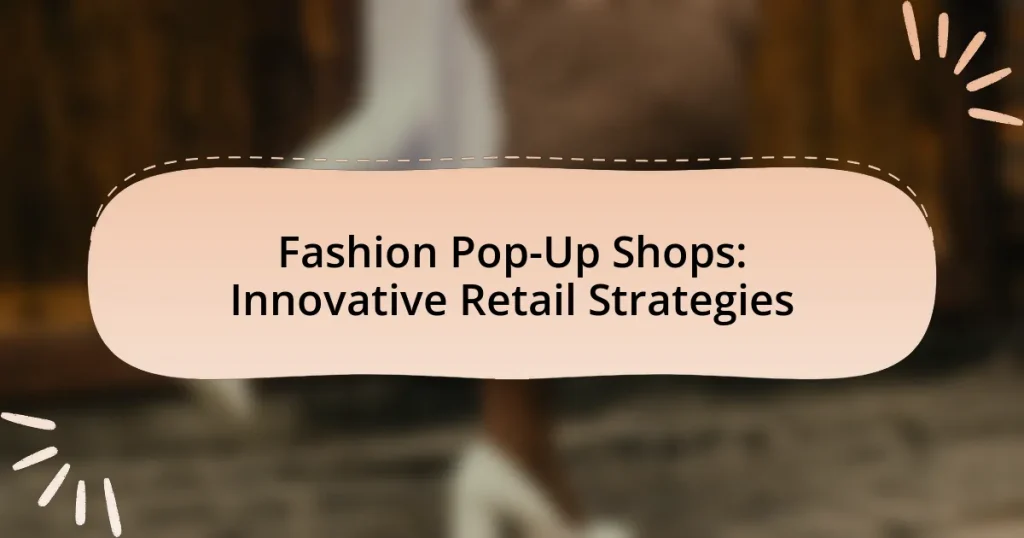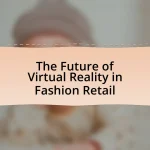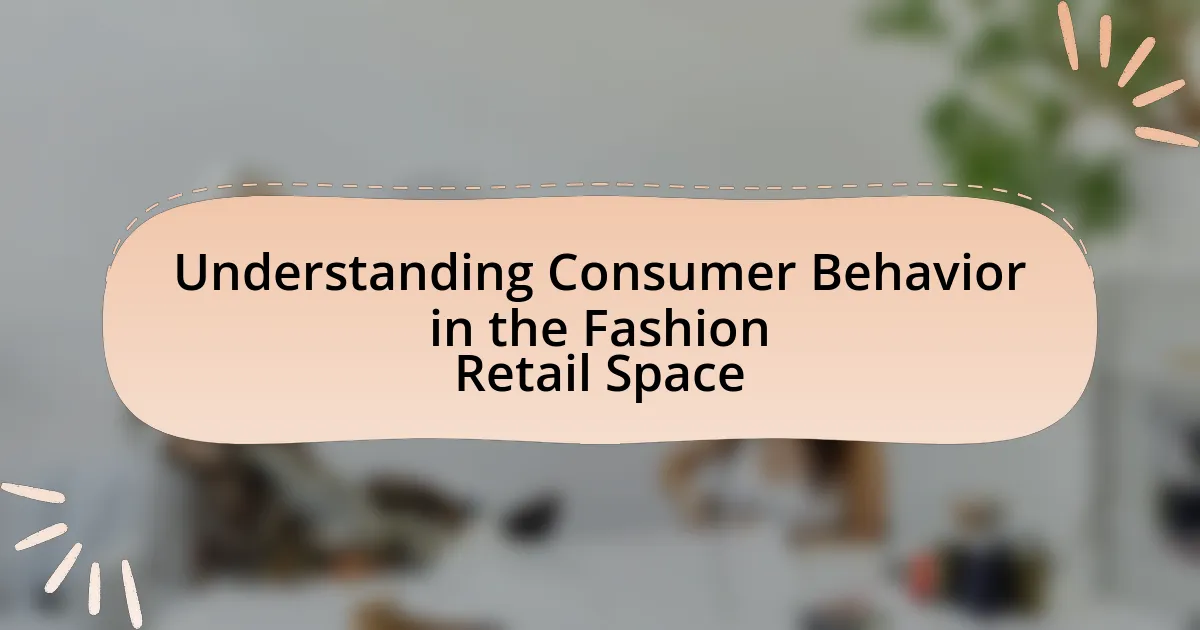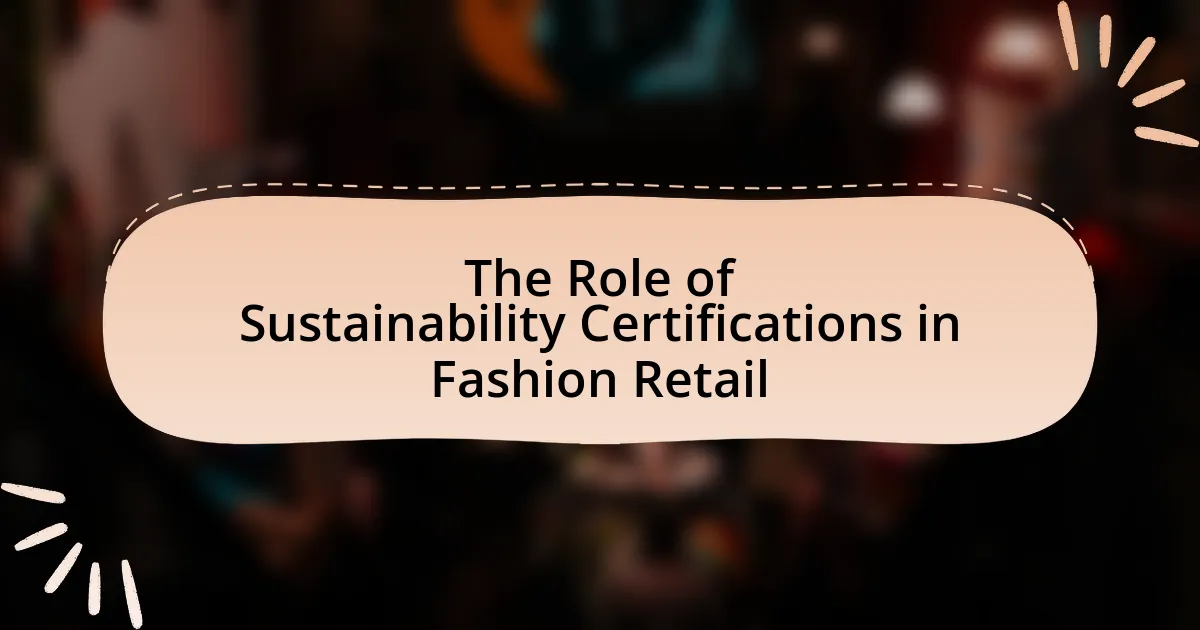Fashion pop-up shops are temporary retail spaces that allow brands to showcase their products for a limited time, creating urgency and exclusivity. This article explores the unique characteristics of fashion pop-up shops, including their differences from traditional retail stores, the various types that exist, and the innovative strategies brands use to enhance customer engagement. It also examines the benefits of pop-up shops for brands, the challenges they face, and how to measure their success through key performance indicators. Additionally, the article discusses future trends in pop-up retail, including the integration of technology and sustainability practices.
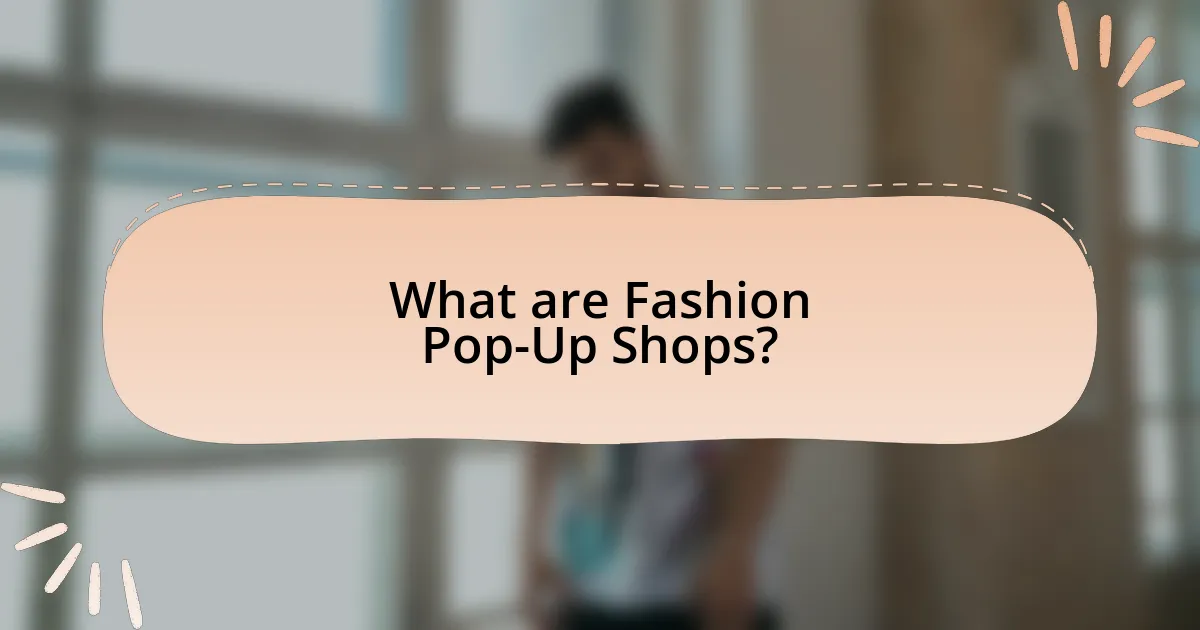
What are Fashion Pop-Up Shops?
Fashion pop-up shops are temporary retail spaces that allow brands to showcase their products for a limited time. These shops often create a sense of urgency and exclusivity, attracting customers who are eager to experience unique offerings. According to a report by the International Council of Shopping Centers, 80% of consumers are more likely to visit a pop-up shop than a traditional store, highlighting their effectiveness in engaging customers and driving sales.
How do Fashion Pop-Up Shops differ from traditional retail stores?
Fashion pop-up shops differ from traditional retail stores primarily in their temporary nature and experiential focus. Pop-up shops are short-term retail spaces that allow brands to create unique shopping experiences, often in unconventional locations, while traditional retail stores operate on a permanent basis with a consistent inventory. For instance, pop-up shops can last from a few days to several months, enabling brands to test markets or launch new products without the long-term commitment associated with traditional storefronts. This flexibility allows for rapid adaptation to consumer trends, as evidenced by the rise of pop-up shops during events like fashion weeks or holiday seasons, where brands can engage customers in a dynamic way.
What unique features define a Fashion Pop-Up Shop?
A Fashion Pop-Up Shop is defined by its temporary nature, unique location, and immersive customer experience. These shops often operate for a limited time, ranging from a few days to several months, allowing brands to create urgency and exclusivity. The locations are typically unconventional, such as vacant storefronts or high-traffic areas, which attract attention and foot traffic. Additionally, Fashion Pop-Up Shops focus on creating an engaging atmosphere through interactive displays, events, and personalized customer service, enhancing the shopping experience and fostering brand loyalty. This approach has been validated by the success of brands like Glossier and Warby Parker, which have utilized pop-up strategies to increase visibility and sales.
Why are Fashion Pop-Up Shops gaining popularity in the retail industry?
Fashion pop-up shops are gaining popularity in the retail industry due to their ability to create unique, immersive shopping experiences that attract consumers. These temporary retail spaces allow brands to test new markets, engage directly with customers, and generate buzz through limited-time offerings. According to a report by the Retail Dive, 80% of consumers are more likely to purchase from a brand that offers a pop-up experience, highlighting the effectiveness of this strategy in driving sales and brand awareness. Additionally, the rise of social media has amplified the visibility of pop-up shops, enabling brands to leverage user-generated content and create a sense of urgency among shoppers.
What types of Fashion Pop-Up Shops exist?
Various types of fashion pop-up shops exist, including seasonal pop-ups, brand collaborations, themed experiences, and online-to-offline (O2O) pop-ups. Seasonal pop-ups typically align with holidays or fashion weeks, allowing brands to capitalize on heightened consumer interest. Brand collaborations involve multiple brands joining forces to create a unique shopping experience, often attracting diverse customer bases. Themed experiences focus on specific concepts or lifestyles, enhancing customer engagement through immersive environments. O2O pop-ups bridge online and offline shopping by allowing customers to experience products in person before purchasing online, reflecting the growing trend of integrating digital and physical retail spaces. These types of pop-up shops are effective strategies for brands to increase visibility and drive sales in a competitive market.
How do seasonal pop-ups differ from themed pop-ups?
Seasonal pop-ups differ from themed pop-ups primarily in their timing and purpose. Seasonal pop-ups are temporary retail spaces that operate during specific times of the year, such as holidays or summer, to capitalize on seasonal demand and trends. For example, a winter holiday pop-up may sell festive clothing and accessories, aligning with consumer shopping habits during that period. In contrast, themed pop-ups focus on a particular concept or narrative, regardless of the season, such as a pop-up dedicated to a specific brand collaboration or cultural event. Themed pop-ups create immersive experiences that engage customers through storytelling and design, independent of seasonal factors. This distinction highlights how seasonal pop-ups are driven by time-sensitive market opportunities, while themed pop-ups emphasize creative concepts and brand identity.
What role do collaborations play in Fashion Pop-Up Shops?
Collaborations play a crucial role in Fashion Pop-Up Shops by enhancing brand visibility and attracting diverse customer bases. These partnerships allow brands to combine resources, share marketing efforts, and create unique shopping experiences that draw in consumers. For instance, a collaboration between a well-known designer and a local artist can generate buzz and increase foot traffic, as seen in successful pop-up events that featured exclusive, limited-edition products. This strategy not only fosters community engagement but also leverages the strengths of each brand, leading to increased sales and brand loyalty.
What are the key benefits of Fashion Pop-Up Shops for brands?
Fashion pop-up shops provide brands with increased visibility, enhanced customer engagement, and the opportunity to test new markets. These temporary retail spaces allow brands to create unique shopping experiences that attract attention and generate buzz, often leading to higher foot traffic and sales. For instance, a study by the National Retail Federation found that 80% of consumers are more likely to purchase from a brand after experiencing a pop-up shop. Additionally, pop-up shops enable brands to gather valuable customer feedback and insights, which can inform future product development and marketing strategies.
How do Fashion Pop-Up Shops enhance brand visibility?
Fashion pop-up shops enhance brand visibility by creating unique, temporary retail experiences that attract attention and generate buzz. These shops often feature exclusive products or limited-time offers, which encourage consumers to visit and engage with the brand. According to a study by the National Retail Federation, 68% of consumers are more likely to purchase from a brand after experiencing a pop-up shop, demonstrating the effectiveness of this strategy in increasing brand awareness and customer loyalty. Additionally, pop-up shops often leverage social media and local marketing to amplify their reach, further enhancing visibility in targeted markets.
What impact do they have on customer engagement?
Fashion pop-up shops significantly enhance customer engagement by creating immersive and unique shopping experiences. These temporary retail spaces foster a sense of urgency and exclusivity, encouraging customers to visit and interact with the brand. According to a study by the Retail Dive, 70% of consumers reported that pop-up shops made them feel more connected to the brand, highlighting the effectiveness of these strategies in building customer relationships. Additionally, pop-up shops often incorporate interactive elements, such as workshops or live demonstrations, which further engage customers and enhance their overall shopping experience.
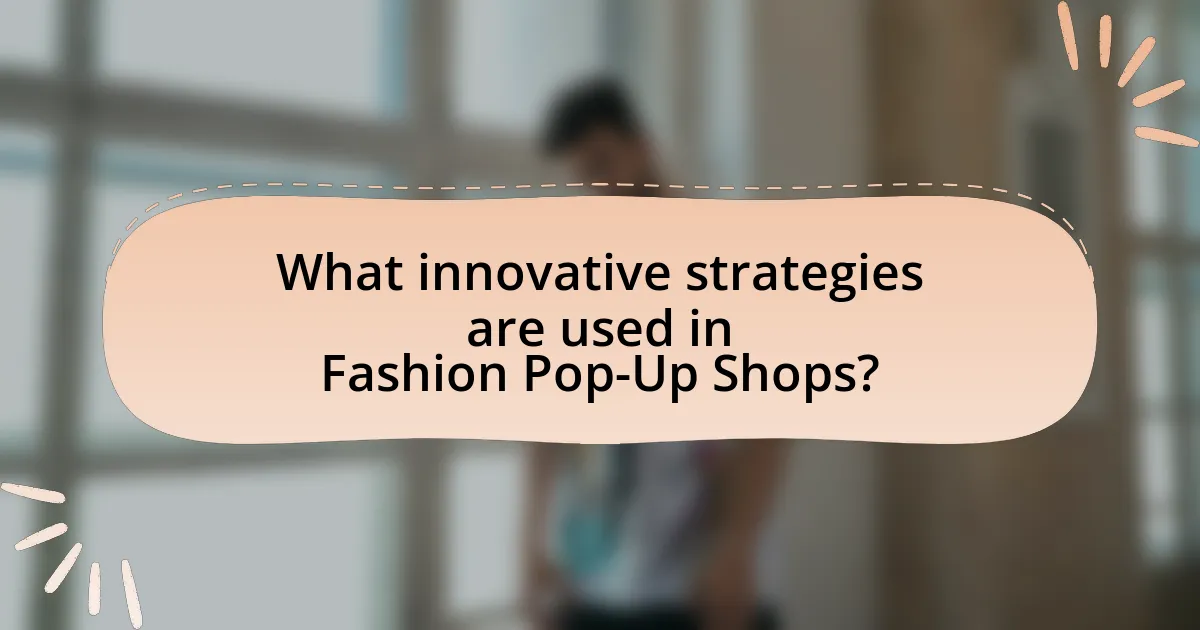
What innovative strategies are used in Fashion Pop-Up Shops?
Fashion pop-up shops utilize innovative strategies such as experiential marketing, limited-time offers, and collaborations with local artists or influencers. Experiential marketing engages customers through interactive experiences, enhancing brand connection; for instance, brands like Glossier have successfully created immersive environments that encourage social media sharing. Limited-time offers create urgency, driving foot traffic and sales, as seen in the success of brands like Nike, which often launch exclusive products in pop-up formats. Collaborations with local artists or influencers not only attract their followers but also create unique, culturally relevant experiences, exemplified by brands like Adidas partnering with local street artists to enhance community engagement. These strategies collectively enhance customer engagement and drive sales in the competitive retail landscape.
How do brands create unique experiences in Fashion Pop-Up Shops?
Brands create unique experiences in Fashion Pop-Up Shops by leveraging immersive environments, personalized interactions, and exclusive offerings. These shops often feature innovative designs that reflect the brand’s identity, creating an engaging atmosphere that attracts customers. For instance, brands may incorporate interactive technology, such as augmented reality, to enhance customer engagement and provide a memorable shopping experience. Additionally, limited-edition products or collaborations exclusive to the pop-up shop create a sense of urgency and exclusivity, encouraging immediate purchases. According to a study by the Retail Industry Leaders Association, 70% of consumers reported that unique experiences significantly influence their purchasing decisions, highlighting the effectiveness of these strategies in driving sales and brand loyalty.
What role does technology play in enhancing the shopping experience?
Technology significantly enhances the shopping experience by providing personalized interactions and streamlined processes. For instance, augmented reality (AR) allows customers to visualize products in their own environment, increasing engagement and satisfaction. According to a study by Deloitte, 40% of consumers are willing to pay more for a better shopping experience, which technology facilitates through features like mobile payment options and virtual fitting rooms. These innovations not only improve convenience but also foster a deeper connection between consumers and brands, ultimately driving sales and customer loyalty.
How can storytelling be effectively utilized in pop-up environments?
Storytelling can be effectively utilized in pop-up environments by creating immersive experiences that engage customers emotionally and enhance brand connection. For instance, fashion brands can use narrative elements such as themed decor, interactive displays, and live demonstrations to convey their brand story, making the shopping experience memorable. Research indicates that 65% of consumers are more likely to purchase from a brand that tells a compelling story, highlighting the importance of narrative in influencing consumer behavior. By integrating storytelling into the design and execution of pop-up shops, brands can foster deeper relationships with their audience, ultimately driving sales and brand loyalty.
What marketing strategies are effective for Fashion Pop-Up Shops?
Effective marketing strategies for fashion pop-up shops include leveraging social media, creating exclusive events, and utilizing local partnerships. Social media platforms like Instagram and TikTok are crucial for generating buzz and attracting customers, as they allow for visually engaging content that showcases products and the pop-up experience. Exclusive events, such as launch parties or influencer meet-and-greets, create a sense of urgency and exclusivity, encouraging attendance and purchases. Additionally, collaborating with local businesses can enhance visibility and draw in diverse customer bases, as seen in successful pop-up campaigns that have reported increased foot traffic and sales through community engagement.
How can social media be leveraged to promote a pop-up event?
Social media can be leveraged to promote a pop-up event by creating targeted advertising campaigns, engaging content, and utilizing influencer partnerships. Targeted advertising on platforms like Facebook and Instagram allows businesses to reach specific demographics, increasing visibility among potential attendees. Engaging content, such as behind-the-scenes videos or countdown posts, generates excitement and encourages sharing, which can amplify reach. Additionally, collaborating with influencers who align with the brand can attract their followers, further expanding the event’s audience. According to a study by Sprout Social, 64% of consumers make a purchase after watching a branded social video, highlighting the effectiveness of visual content in driving attendance.
What partnerships can enhance the reach of a Fashion Pop-Up Shop?
Collaborations with local influencers and social media personalities can significantly enhance the reach of a Fashion Pop-Up Shop. These partnerships leverage the influencers’ established audiences, allowing the shop to tap into new customer bases. For instance, a study by the Digital Marketing Institute found that 49% of consumers depend on influencer recommendations, highlighting their impact on purchasing decisions. Additionally, partnering with complementary brands, such as local cafes or beauty salons, can create cross-promotional opportunities, driving foot traffic and increasing visibility. According to a report by Eventbrite, 78% of consumers are more likely to attend an event if it is co-hosted by a brand they trust, further validating the effectiveness of strategic partnerships in expanding reach.
What challenges do Fashion Pop-Up Shops face?
Fashion pop-up shops face several challenges, including high operational costs, limited timeframes, and fluctuating consumer interest. High operational costs arise from expenses related to leasing temporary spaces, staffing, and inventory management, which can strain budgets. Limited timeframes create pressure to generate sales quickly, often leading to rushed marketing efforts. Additionally, fluctuating consumer interest can result in unpredictable foot traffic, making it difficult to forecast sales and manage inventory effectively. These challenges necessitate strategic planning and adaptability to succeed in the competitive retail landscape.
How can brands overcome logistical challenges in setting up pop-ups?
Brands can overcome logistical challenges in setting up pop-ups by implementing thorough planning and utilizing technology for efficient operations. Effective planning involves identifying the right location, securing necessary permits, and coordinating with suppliers to ensure timely delivery of products. For instance, brands can use project management tools to streamline communication and track progress, which enhances coordination among team members. Additionally, leveraging inventory management software can help brands maintain optimal stock levels and reduce the risk of overstocking or stockouts. According to a study by the National Retail Federation, 70% of retailers reported that technology improved their operational efficiency, demonstrating the effectiveness of these strategies in addressing logistical hurdles.
What are the common pitfalls to avoid when launching a pop-up shop?
Common pitfalls to avoid when launching a pop-up shop include inadequate market research, poor location selection, insufficient inventory management, and lack of marketing strategy. Inadequate market research can lead to misunderstanding customer preferences, resulting in low foot traffic and sales. Poor location selection, such as choosing a site with low visibility or foot traffic, can severely limit customer access. Insufficient inventory management may cause stockouts or overstock situations, negatively impacting sales and customer satisfaction. Lastly, a lack of a well-defined marketing strategy can prevent potential customers from being aware of the pop-up shop, leading to missed opportunities for engagement and sales. These pitfalls can significantly hinder the success of a pop-up shop, as evidenced by numerous case studies highlighting the importance of strategic planning in retail ventures.
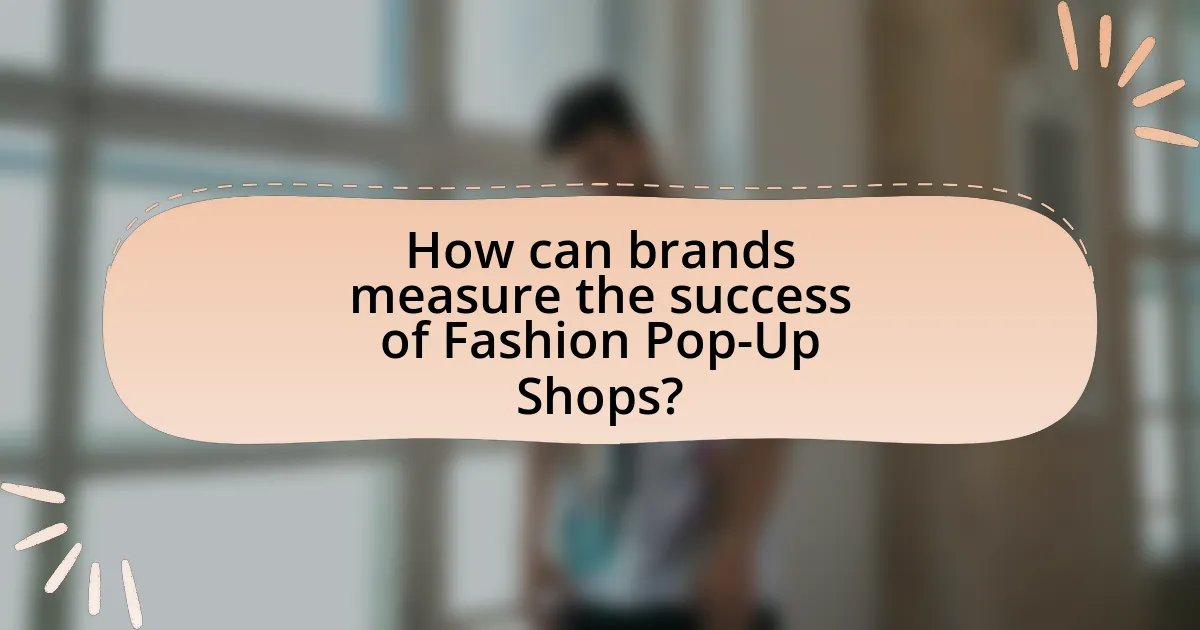
How can brands measure the success of Fashion Pop-Up Shops?
Brands can measure the success of Fashion Pop-Up Shops through key performance indicators (KPIs) such as sales revenue, foot traffic, customer engagement, and social media impact. Sales revenue provides a direct financial measure of success, while foot traffic indicates the number of visitors, which can be tracked using tools like mobile analytics or in-store counters. Customer engagement can be assessed through surveys or feedback forms, revealing insights into customer satisfaction and brand perception. Additionally, social media impact can be evaluated by monitoring mentions, shares, and overall reach during and after the event, reflecting brand visibility and consumer interest. These metrics collectively offer a comprehensive view of the effectiveness of pop-up shops in achieving brand objectives.
What metrics should be tracked to evaluate performance?
To evaluate performance in fashion pop-up shops, key metrics include sales revenue, foot traffic, conversion rate, average transaction value, and customer feedback. Sales revenue indicates overall financial success, while foot traffic measures the number of visitors, providing insight into marketing effectiveness. Conversion rate, calculated by dividing the number of purchases by foot traffic, reveals how well the shop turns visitors into buyers. Average transaction value, determined by dividing total sales by the number of transactions, helps assess customer spending behavior. Customer feedback, gathered through surveys or social media, offers qualitative insights into customer satisfaction and areas for improvement. These metrics collectively provide a comprehensive view of a pop-up shop’s performance.
How can customer feedback be effectively gathered and analyzed?
Customer feedback can be effectively gathered and analyzed through structured surveys, social media monitoring, and direct interactions during pop-up events. Surveys, both online and in-person, allow businesses to collect quantitative data on customer preferences and satisfaction levels. Social media monitoring tools can track customer sentiments and comments, providing qualitative insights into brand perception. Additionally, engaging customers directly during pop-up events through conversations or feedback forms can yield immediate and relevant insights. According to a study by the Harvard Business Review, companies that actively seek customer feedback can improve their customer retention rates by up to 25%, demonstrating the importance of effective feedback mechanisms.
What role does sales data play in assessing success?
Sales data is crucial in assessing success as it provides measurable insights into revenue generation and customer engagement. By analyzing sales data, businesses can identify trends, evaluate the effectiveness of marketing strategies, and make informed decisions regarding inventory and pricing. For instance, a study by McKinsey & Company found that companies leveraging data analytics in sales can increase their profitability by 5-10%. This demonstrates that sales data not only reflects past performance but also guides future strategies, making it an essential tool for evaluating success in retail environments like fashion pop-up shops.
What best practices should brands follow when planning a Fashion Pop-Up Shop?
Brands should focus on strategic location, effective marketing, and engaging customer experiences when planning a Fashion Pop-Up Shop. Selecting a high-traffic area ensures maximum visibility and foot traffic, which is crucial for attracting potential customers. Effective marketing, including social media promotion and collaborations with local influencers, can create buzz and drive attendance. Engaging customer experiences, such as interactive displays or exclusive product launches, enhance brand connection and encourage purchases. According to a study by the Retail Industry Leaders Association, 70% of consumers are more likely to visit a pop-up shop if they are aware of it through social media, highlighting the importance of marketing in driving foot traffic.
How can brands ensure a seamless customer experience?
Brands can ensure a seamless customer experience by integrating technology and personalizing interactions. Utilizing data analytics allows brands to understand customer preferences and behaviors, enabling tailored marketing strategies that enhance engagement. For instance, a study by McKinsey found that companies using advanced analytics to personalize customer interactions can increase sales by 10% to 20%. Additionally, implementing omnichannel strategies ensures that customers receive a consistent experience across all platforms, whether online or in-store. This approach not only improves customer satisfaction but also fosters brand loyalty, as evidenced by a report from Salesforce indicating that 70% of consumers say connected processes are very important to winning their business.
What are the key elements of a successful pop-up shop layout?
A successful pop-up shop layout includes strategic placement of products, effective use of space, and engaging visual merchandising. Strategic product placement ensures that high-demand items are easily accessible, which can increase sales. Effective use of space involves creating a flow that guides customers through the shop, maximizing engagement and interaction with products. Engaging visual merchandising, such as eye-catching displays and cohesive branding, captures attention and enhances the shopping experience. Research indicates that well-designed layouts can increase customer dwell time and boost sales by up to 30%, demonstrating the importance of these key elements in driving retail success.
What are the future trends for Fashion Pop-Up Shops?
Future trends for fashion pop-up shops include increased integration of technology, sustainability practices, and experiential marketing. The use of augmented reality (AR) and virtual reality (VR) is expected to enhance customer engagement by allowing shoppers to visualize products in innovative ways. According to a report by Grand View Research, the global AR market in retail is projected to reach $61.4 billion by 2023, indicating a strong trend towards tech-driven shopping experiences.
Additionally, sustainability will play a crucial role, with brands focusing on eco-friendly materials and practices to attract environmentally conscious consumers. A survey by McKinsey & Company found that 67% of consumers consider sustainability when making a purchase, highlighting the importance of this trend in pop-up retail strategies.
Lastly, experiential marketing will continue to be a key focus, as brands aim to create memorable experiences that foster customer loyalty. Research from Eventbrite shows that 78% of consumers prefer to spend money on experiences rather than products, suggesting that pop-up shops will increasingly prioritize unique, interactive events to draw in customers.
How might sustainability influence the design of future pop-ups?
Sustainability will significantly influence the design of future pop-ups by prioritizing eco-friendly materials and practices. Designers will increasingly utilize biodegradable, recycled, or upcycled materials to minimize environmental impact, aligning with consumer demand for sustainable options. For instance, a report by McKinsey & Company highlights that 67% of consumers consider sustainability when making purchasing decisions, indicating a strong market trend towards eco-conscious retail. Additionally, future pop-ups may incorporate modular designs that allow for easy disassembly and reuse, further reducing waste. This shift not only meets consumer expectations but also enhances brand reputation in a competitive market focused on sustainability.
What emerging technologies could shape the future of pop-up retail?
Emerging technologies that could shape the future of pop-up retail include augmented reality (AR), artificial intelligence (AI), and mobile payment solutions. AR enhances customer engagement by allowing shoppers to visualize products in their environment, which can lead to increased sales; for instance, IKEA’s AR app enables users to see how furniture fits in their homes. AI can optimize inventory management and personalize marketing strategies, as demonstrated by companies like Stitch Fix, which uses algorithms to recommend clothing based on customer preferences. Mobile payment solutions streamline the checkout process, making transactions faster and more convenient, as seen with platforms like Apple Pay and Google Wallet, which have gained significant adoption in retail environments. These technologies collectively enhance the shopping experience, drive efficiency, and foster customer loyalty in pop-up retail settings.
